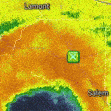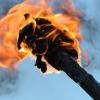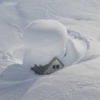Records:
Highs:
EWR: 97 (1993)
NYC: 95 (1948)
LGA: 96 (1948)
JFK: 97 (1969)
Lows:
EWR: 48 (1940)
NYC: 52 (1940)
LGA: 53 (1940)
JFK: 54 (1987)
Historical:
1635: Boston, Massachusetts region hit by the "Great Colonial Hurricane". (Ref. NOAA Boston Weather Events) (Ref. AccWeather Weather History)
1814 - In the early afternoon, a strong tornado struck northwest Washington D.C. and downtown. The severe tornadic storm arrived the day after the British Troops had set fire to the Capitol, the White House, and other public buildings. The storm's rains would douse those flames. The tornado did major structural damage to the residential section of the city. The tornado's flying debris killed more British soldiers than by the guns of the American resistance. The storm blew off roofs and carried them high up into the air, knocked down chimneys and fences and damaged numerous homes. Some homes were destroyed. It lifted two pieces of cannon and deposited them several yards away. At least 30 Americans were killed or injured in the heavily damaged buildings, and an unknown number of British killed and wounded.
1885 - A severe hurricane struck South Carolina causing 1.3 million dollars damage at Charleston. (David Ludlum)
1910: Bowen, MT set the record for lowest temperature ever observed in the lower 48 states in August with a reading of 5 °F. Wisdom, MT was not very far behind with a reading of 11°. Great Falls, MT set an early season and August record snowfall of 8.3 inches on the 22nd and 23rd, while St. Mary, MT reported a foot. Cheyenne, WY reported an all-time August record low of 25°, while Scottsbluff, NE set their lowest August temperature and earliest freeze on record, with a low of 30°. Kimball, NE recorded a low of 26° while the temperature fell to 25° near Lusk, WY. (Ref. AccWeather Weather History)
1914: Boston, Massachusetts had its lowest maximum temperature for August of 57 °F. (Ref. NOAA Boston Weather Events)
1940 - New Jersey experienced its coldest August morning of record, with lows of 32 degrees at Layton and Charlotteburg. (The Weather Channel)
1958: Record chill occurred across parts of the upper Midwest. Cities recording their coldest August temperature included: Austin, MN: 34°, Decorah, IA: 35°, and Genoa, WI: 41°. (Ref. Additional Temperatures Listed On This Link)
1972: Philadelphia, PA measured their 25th consecutive day without measurable rainfall. (Ref. AccWeather Weather History)
1974: Ocala, Fla.--Lightning struck a lakeside dock just west of Ocala killing a 17-year-old boy and injuring five other youths. Tampa, Fla.--A 32-year-old Largo, Fla. woman was killed and two children were injured when lightning struck into a crowd watching an air show at McDill Air Force Base. The two children injured were the woman's 3-year-old son and an 11-year-old Clearwater girl. (Ref. Lightning-The Underrated Killer.pdf)
1987 - Morning thunderstorms produced heavy rain in eastern Nebraska and southwestern Iowa. Stanton IA reported 10.50 inches of rain. Water was reported up to the handle of automobiles west of Greenwood NE. Rainfall totals for a two day period ranged from 7 to 14 inches across southwestern Iowa. Crop damage was in the millions for both states. Subsequent flooding of streams in Iowa the last week of August caused millions of dollars damage to crops, as some streams crested ten feet above flood stage. (Storm Data)
1988 - Seven cities in California reported record high temperatures for the date, including Sacramento with an afternoon reading of 104 degrees. Thunderstorms produced locally heavy rains in Arizona. Chino Valley was drenched with 2.50 inches of rain in just thirty minutes washing out a couple of streets in town. (The National Weather Summary)
1989 - Morning thunderstorms drenched Spencer, IN, with 4.10 inches of rain in three hours causing extensive street flooding. Evening thunderstorms in eastern Kansas produced up to six inches of rain around Emporia, and four inches of rain in just forty-five minutes near Parsons, and also produced wind gusts to 70 mph at Lake Melvern. (The National Weather Summary) (Storm Data)
1992: After unleashing sustained winds of around 165 mph around Homestead/Florida City, FL, Hurricane Andrew headed for the Louisiana coast. Hurricane Warnings were posted from Pascagoula, MS to the Bolivar Peninsula on the northeast Texas coast. Billings, MT fell to 35°, their coldest August temperature on record. This was the 3rd consecutive day with a low temperature in the 30s at that location.(Ref. AccWeather Weather History) (Ref. Wilson Wx. History)
1993: In Augusta County, VA people took refuge from a thunderstorm under a solitary tree. Lightning struck the tree and injured four people.(Ref. Lightning - Virginia Weather History)
1998: Torrential tropical downpours from the remnants of Tropical Storm Charley caused flash flooding along Texas State Highway 349 between Iraan and Sheffield. Just south of Iraan fast moving waters swept pavement away from this highway. Unconfirmed reports of 7 inches of rain were received from citizens of Sheffield.(Ref. Wilson Wx. History)
2003: Record high temperatures occurred across parts of the Midwest. Rockford, IL set a new record high with 97° while O’Hare Airport in Chicago, IL tied their record high with 95°. (Ref. Wilson Wx. History)
2005 - Katrina becomes a hurricane just before landfall in south Florida between Hallandale Beach and North Miami Beach. Maximum sustained winds at the time of landfall were near 80 mph. There were eleven fatalities in South Florida, including four by falling trees. More than 1.3 million customers lost electrical services, and preliminary insured loss estimates ranged from $600 million to $2 billion in the state of Florida (Associated Press).
2011: Earthquake Aftershock West Henrico Co. - Glen Allen VA. area had another 4.5 aftershock this morning at 1:07 AM that woke us up as it rattled the pulls on the chest of drawers. (West Henrico Co. - Glen Allen VA. Weather Station )
2017: Harvey's intensification phase stalled slightly overnight from August 24–25, however Harvey soon resumed strengthening and became a Category 4 hurricane late on August 25. Hours later, Harvey made landfall near Rockport, Texas, at peak intensity. The strongest winds were focused just northeast of Corpus Christi, around Rockport. The highest reading of 132 mph was registered at Port Aransas. (Satellite-before-Landfall on the 24-25 landfall near Rockport, Texas) (Harvey made landfall near Rockport, Texas)(2017 Hurricane Summary Weatherwise Harvey,Irma,Maria)
2020: Tuesday-August 25 Entering over the waters of the southeastern Gulf of Mexico during the predawn hours of Tuesday, Laura became better organized and began strengthening to become the fourth hurricane of 2020 after sunrise as NOAA hurricane hunter aircraft data determined that maximum sustained surface winds had reached 75 mph. At the time, the center of Hurricane Laura was continuing toward the west-northwest and was located approximately 145 miles to the northwest of the western tip of Cuba. Throughout the remainder of Tuesday Laura continued to strengthen slightly while traveling to the west-northwest across the waters of the central Gulf of Mexico. During the predawn hours, Hurricane Laura strengthened to a category two hurricane as it began to curve to take a track toward the northwest and then to a major category 3 hurricane as winds reached 115 mph as the hurricane's center was slightly less 300 miles to the south of the Louisiana Gulf Coast. Thus, Laura became the first major hurricane of the 2020 Atlantic hurricane season.


















